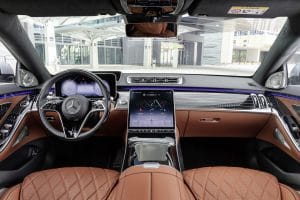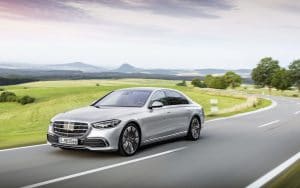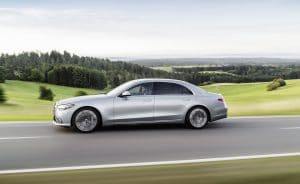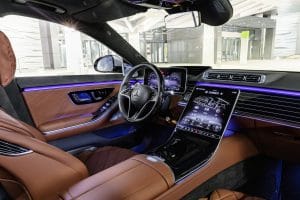The complete makeover of the Mercedes-Benz S-Class announced this week will be a technological showcase, but the German automaker has plans to significantly upgrade the big sedan during the next few years, notably adding what one executive called the “big, big, big step” of adding full hands-free driving capabilities.
Automakers around the world have been racing to bring autonomous driving to market but the S-Class is on track to become the first to deliver Level 3 functionality, said Michael Hafner, Daimler AG’s Director of Driver Assistance Systems. And the goal is to push even further, upgrading to Level 4 technology – which would allow the S-Class to operate without a driver behind the wheel.
“We are planning to launch Level 3 technology in the second half of 2021,” said Hafner during a media roundtable. “It is a big, big, big step to hand over control to the car.”
(First Look: 2021 Mercedes-Benz S-Class.)
At launch, the 2021 Mercedes-Benz S-Class will offer a significant amount of advanced driver assistance systems, or ADAS, including steering assistance and various obstacle detection technologies that can help avoid an inadvertent collision, but a driver will still have to maintain hands on the wheel.

Mercedes Drive Pilot allows the driver to take their hands off the wheel at speeds up to 37 mph — for now.
The Drive Pilot upgrade will permit a motorist to fully hand over control to the vehicle itself, albeit under limited circumstances, Hafner noted, primarily due to regulatory restrictions. In Germany, where the Level 3 function will first be offered, current rules allow operation only up to 60 kilometers an hour, or about 37 mph. That would largely limit its use to heavy traffic situations. But he added that regulators are preparing to allow higher speed operation.
Plans call for introducing the Level 3 technology in other markets, including China and the U.S. as the rules change in those countries. The problem with the States, said Hafner, is that it currently has a patchwork of state regulations, Congress stuck debating a national autonomous rule measure for several years.
Mercedes actually won’t be the first to have a hands-free feature. General Motors now offers a more limited Level 2 system on several Cadillac models and Tesla has its Autopilot technology. The EV maker has also been promising to bring full autonomy to market but continues to push back its target date.
Though Hafner claimed Drive Pilot will be significantly more capable than those two systems, they will have some things in common. As with Super Cruise, for one thing, the Mercedes technology initially will be restricted to limited-access roadways or those with barriers or spacing between oncoming lanes.

For 2021, the S-Class will offer the Level 3 version of Drive Pilot, but the car can receive over-the-air updates so it could ultimately get upgraded to Level 4.
“When we start next year we plan to cover 90% of German highways,” said Hafner, adding “We will not allow a driver to sleep or put the seat in a very strange position.”
(Mercedes-Benz E-Class wagon gets updates for 2021.)
Despite being able to fully take control of all vehicle functions, including being able to pass slower traffic without human intervention, a driver will need to be in a position to take control within 10 seconds, according to German law. That might happen if there is a problem with the system, or when it approaches a point where it is designed to return control to the driver, such as exiting a freeway.
To achieve Level 3 capabilities, the new S-Class will be loaded up with cameras, radar and other now-common sensors But it also will add LIDAR, a type of high-resolution, 3D laser sensing. Most experts believe that will be essential to full autonomy – though Tesla believes it will be able to achieve that goal without LIDAR. The technology is expensive, though prices are falling and Hafner said the factory cost for a single sensor will be “below $1,000,” down from the $75,000 many suppliers were quoting just a few years ago.
Inside the car, meanwhile, there will be a camera system monitoring drivers to ensure they are ready to take control.
By using over-the-air communications capabilities built into the new S-Class, Mercedes plans to monitor how Drive Pilot performs. That will allow it to tweak the software and eventually upgrade the system when, for example, Germany permits higher-speed operation.
Eventually, the goal is to give the S-Class even more capabilities, bumping up to Level 4 autonomy. That would be a big jump, permitting drivers to completely disengage, perhaps to fall asleep or even turn seats around, turning the cabin into a mobile living room. The car might be able to operate without a driver, in fact.
Level 4 technology would still be “geo-fenced,” however, meaning limits to what roads it could operate on and under certain other restrictions, such as weather conditions.
(Mercedes offers look at pre-production AMG-powered SL model.)
While Drive Pilot will have a slow roll out, Mercedes plans to add other autonomous capabilities to the new S-Class. That includes the ability for a driver to exit the vehicle when entering a parking structure and have the car go off and slip into a spot entirely on its own. That will, however, require parking lots to be equipped with their own communications infrastructure, so it could be some years before this feature can be readily used.


